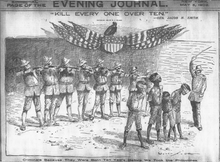| Pacification of Samar | |
|---|---|
| Part of the post-war insurgency phase of the Philippine–American War | |
 Editorial cartoon depicting atrocities carried out by U.S. Marines during the Samar campaign | |
| Location | |
| Planned by | General Jacob H. Smith |
| Commanded by | General Adna Chaffee |
| Objective | Neutralize rogue guerilla force following conclusion of general hostilities |
| Date | December 8, 1901– February 22, 1902 |
| Executed by | U.S. Army, U.S. Marines |
| Outcome | Objective achieved but with significant collateral damage and noncombatant casualties |
| Casualties | Most estimates range from between 2,000 and 2,500 victims; 5,000 according to other sources. Some estimates are as high as 50,000, albeit these are supported by population figures now known to be a result of typographical errors and the misreading of documents.[1] |
The Pacification of Samar was an operation initiated by General Adna Chaffee following the Balangiga massacre. General hostilities in the Philippine-American War had largely ceased following the capture of Emilio Aguinaldo, president of the insurgent Philippine Republic, and his publication of a manifesto on April 10, 1901 acknowledging and accepting U.S. sovereignty throughout the Philippines.[2]
General Vicente Lukban had been the commander, under Aguinaldo, of a guerilla force on the island of Samar and had, when offered the opportunity to surrender, replied that he intended to fight on to the end.[3] In September, in an action that became known as the Balangiga massacre, Lukban's forces assisted by townspeople in a surprise uprising inflicted 54 killed and 18 wounded on a U.S. Army company garrisoning that town.[4] Following this, General Jacob H. Smith was tasked with the pacification of Samar.[5]

- ^ Bartrop, P.R.; Jacobs, S.L. (2014). Modern Genocide: The Definitive Resource and Document Collection [4 volumes]: The Definitive Resource and Document Collection. ABC-CLIO. p. 1983. ISBN 978-1-61069-364-6.
[I]t is now known that the oft-quoted figure of 50,000 was based on typographical errors and misreading of documents.
- ^ "Today in Filipino History, April 19, 1901, Aguinaldo issued Peace Manifesto after his capture and after his Oath of Allegiance to the United States". Office of the Military Governor in the Philippine Islands. n.d. [April 19, 1901]. Retrieved September 19, 2024.
- ^ Miller 1982, p. 199.
- ^ Multiple sources, including:
- Taylor, James O. (1931). The Massacre of Balangiga: Being an Authentic Account by Several of the Few Survivors. McCarn Printing Company.
- Borrinaga, Rolando O. (2003). The Balangiga Conflict Revisited. New Day Publishers. pp. 114, 194, 197. ISBN 978-971-10-1090-4.
- Linn, Brian McAllister (2000), "Samar", The Philippine War, 1899–1902, University Press of Kansas, pp. 306–321, doi:10.2307/j.ctvgs0c6m, ISBN 9780700612253, JSTOR j.ctvgs0c6m – via Jstor
- ^ Feight, Andrew (n.d.). "General Jacob H. Smith & the Philippine War's Samar Campaign". sciotohistorical.org. Retrieved September 19, 2024.